Influence of Black Carbon on Measurement Errors in Scattering-Based Visibility Meters
Abstract
1. Introduction
2. Materials and Methods
2.1. Calculation for Er in Visibility Meters
- D represents the particle diameter, with the calculation range from 0.01 to 10 μm and a step size of 0.001 μm.
- Qext and Qabs are the extinction efficiency factor and absorption efficiency factor, respectively. ρ is the density, with values for black carbon and scattering aerosol particles set at 1.8 g∙cm−3 and 1.2 g∙cm−3, respectively.
- n(D) is the aerosol size distribution function, representing the number of aerosol particles per unit volume within an infinitesimally small size interval from D to D + ΔD.
2.2. Data Sources
- Field Observation Data: The data are derived from the “Vertical Distribution, Physicochemical Coupling, and Meteorological Effects of Fine Particulate Matter and Ozone in the Yangtze River Delta” project, conducted from 4 August to 22 September 2016, at the Nanjing University Gulou Station (32.05° N, 118.78° E). During this period, black carbon mass concentration, PM2.5 particle mass concentration, and atmospheric scattering coefficients were measured every 5 min. The station is located on the rooftop of an 80 m tall teaching building at the Gulou campus of Nanjing University, with an elevation of 20 m. Situated in an urban area, the primary pollution sources around the station are vehicle emissions and residential activities.
- Non-absorptive Aerosols in Typical Regions (Figure 1, Figure 2 and Figure 3): The particle size distribution data were obtained from Hussein et al. [24] and Guo [3], which provided tri-modal fits and normalised number spectra for aerosols in urban, marine, rural, and remote land regions. These data were then used to calculate the mass scattering coefficient (MSC).
3. Results and Discussion
3.1. Impact of Black Carbon on Er in Scattering-Based Visibility Meters Under Monodisperse Conditions
3.2. Impact of Particle Size Distribution on Er in Scattering-Based Visibility Meters
3.3. Case Analysis of the Impact of Black Carbon on Er at Gulou Station During the Fall Season
4. Conclusions
- The impact of black carbon on Er is significant and exhibits considerable variability. Both observational data and theoretical analysis show that the large variations in mass concentration and MAC of black carbon result in marked differences in the contribution of its ACC to the total extinction coefficient, thereby influencing the measurement error in visibility.
- The relationship between black carbon mass fraction and Er is intricate. While an increase in black carbon mass fraction typically leads to an elevated rise in Er, cases exist where a lower black carbon mass fraction may also lead to a higher value of Er. This indicates that the relationship between the mass fraction of black carbon and Er is not a simple linear one, but is significantly influenced by aerosol physicochemical parameters such as particle size distribution and mixing state.
- Calibration recommendations for scattering-based visibility meters. Considering the impact of black carbon on the measurement error of instruments, the calibration procedure should be divided into two stages. First, the visibility measurement performance of the instrument should be calibrated to ensure its fundamental accuracy. Second, a calibration specifically accounting for the influence of black carbon should be implemented. Specifically, if real-time data on the mass fraction of black carbon are unavailable, a fixed calibration coefficient based on historical observations may be used; if real-time mass fraction data can be obtained, it is assumed to be proportional to the absorption coefficient contribution (ACC) and Equation (1) is applied for calibration; if ACC data are available directly, Equation (1) should be applied without modification.
Author Contributions
Funding
Institutional Review Board Statement
Informed Consent Statement
Data Availability Statement
Acknowledgments
Conflicts of Interest
Abbreviations
| MAC | mass absorption coefficient |
| MEC | mass extinction coefficient |
| MSC | mass scattering coefficient |
| Er | relative error |
References
- Cheng, X.; Yang, B.; Liu, G.; Olofsson, T.; Li, H. A variational approach to atmospheric visibility estimation in the weather of fog and haze. Sustain. Cities Soc. 2018, 39, 215–224. [Google Scholar] [CrossRef]
- Barrales-Guadarrama, R.; Mocholí-Salcedo, A.; Rodríguez-Rodríguez, M.E.; Barrales-Guadarrama, V.R.; Vázquez-Cerón, E.R. A new forward-scatter visibility sensor based on a universal frequency-to-digital converter. Instrum. Sci. Technol. 2013, 41, 445–462. [Google Scholar] [CrossRef]
- Guo, H.; Zhang, Z.; Jiang, L.; An, J.; Zhu, B.; Kang, H.; Wang, J. Ångström exponent errors prevent accurate visibility measurement. Atmos. Meas. Tech. 2021, 14, 2441–2450. [Google Scholar] [CrossRef]
- Zhang, Z.; Guo, H.; Kang, H.; Wang, J.; An, J.; Yu, X.; Lv, J.; Zhu, B. A new method for calculating average visibility from the relationship between extinction coefficient and visibility. Atmos. Meas. Tech. 2022, 15, 7259–7264. [Google Scholar] [CrossRef]
- Zhuang, Z.; Li, J.; Chan, P.W.; Tai, H. Substitutability research for forward-scatter meters in indoor low-visibility environments. Meteorol. Appl. 2022, 29, e2050. [Google Scholar] [CrossRef]
- Shen, Z.; Cao, J.; Zhang, L.; Zhang, Q.; Huang, R.-J.; Liu, S.; Zhao, Z.; Zhu, C.; Lei, Y.; Xu, H.; et al. Retrieving historical ambient PM2.5 concentrations using existing visibility measurements in Xi’an, Northwest China. Atmos. Environ. 2016, 126, 15–20. [Google Scholar] [CrossRef]
- Jeong, J.I.; Seo, J.; Park, R.J. Compromised improvement of poor visibility due to PM chemical composition changes in South Korea. Remote Sens. 2022, 14, 5310. [Google Scholar] [CrossRef]
- World Meteorological Organization. Guide to Instruments and Methods of Observation Volume I—Measurement of Meteorological Variables, 2023 ed.; World Meteorological Organization: Geneva, Switzerland, 2023; p. 574. ISBN 978-92-63-10008-5. [Google Scholar]
- World Meteorological Organization. Guide to Instruments and Methods of Observation, 7th ed.; World Meteorological Organization: Geneva, Switzerland, 2008; Chapter 9; pp. I.9-1–I.9-15. ISBN 978-92-63-10008-5. [Google Scholar]
- Li, J.; Carlson, B.E.; Yung, Y.L.; Lv, D.; Hansen, J.; Penner, J.E.; Liao, H.; Ramaswamy, V.; Kahn, R.A.; Zhang, P.; et al. Scattering and absorbing aerosols in the climate system. Nat. Rev. Earth Environ. 2022, 3, 363–379. [Google Scholar] [CrossRef]
- Liu, D.; He, C.; Schwarz, J.P.; Wang, X. Lifecycle of light-absorbing carbonaceous aerosols in the atmosphere. NPJ Clim. Atmos. Sci. 2020, 3, 40. [Google Scholar] [CrossRef]
- Tang, F.; Ma, S.; Yang, L.; Du, C.; Tang, Y. A new visibility measurement system based on a black target and a comparative trial with visibility instruments. Atmos. Environ. 2016, 143, 229–236. [Google Scholar] [CrossRef]
- Wei, C.; Zeqiang, B.; Jinhua, C.; Xiaolei, H.; Dandan, J. A method for calibrating forward scatter meters indoors. Metrologia 2020, 57, 065030. [Google Scholar] [CrossRef]
- Cao, N.; Chen, L.; Liu, Y.; Wang, J.; Yang, S.; Su, D.; Mi, K.; Gao, S.; Zhang, H. Spatiotemporal distribution, light absorption characteristics, and source apportionments of black and brown carbon in China. Sci. Total Environ. 2024, 919, 170796. [Google Scholar] [CrossRef] [PubMed]
- Sun, Y.; Jiang, Q.; Wang, Z.; Fu, P.; Li, J.; Yang, T.; Yin, Y. Investigation of the sources and evolution processes of severe haze pollution in Beijing in January 2013. JGR Atmos. 2014, 119, 4380–4398. [Google Scholar] [CrossRef]
- Hu, W.; Hu, M.; Hu, W.; Jimenez, J.L.; Yuan, B.; Chen, W.; Wang, M.; Wu, Y.; Chen, C.; Wang, Z.; et al. Chemical composition, sources, and aging process of submicron aerosols in Beijing: Contrast between summer and winter. JGR Atmos. 2016, 121, 1955–1977. [Google Scholar] [CrossRef]
- Marinoni, A.; Cristofanelli, P.; Laj, P.; Duchi, R.; Calzolari, F.; Decesari, S.; Sellegri, K.; Vuillermoz, E.; Verza, G.P.; Villani, P.; et al. Aerosol mass and black carbon concentrations, a two year record at NCO-P (5079 m, Southern Himalayas). Atmos. Chem. Phys. 2010, 10, 8551–8562. [Google Scholar] [CrossRef]
- Bond, T.C.; Bergstrom, R.W. Light absorption by carbonaceous particles: An investigative review. Aerosol Sci. Technol. 2006, 40, 27–67. [Google Scholar] [CrossRef]
- Saliba, G.; Subramanian, R.; Saleh, R.; Ahern, A.T.; Lipsky, E.M.; Tasoglou, A.; Sullivan, R.C.; Bhandari, J.; Mazzoleni, C.; Robinson, A.L. Optical properties of black carbon in cookstove emissions coated with secondary organic aerosols: Measurements and modeling. Aerosol Sci. Technol. 2016, 50, 1264–1276. [Google Scholar] [CrossRef]
- Martins, J.V.; Artaxo, P.; Liousse, C.; Reid, J.S.; Hobbs, P.V.; Kaufman, Y.J. Effects of black carbon content, particle size, and mixing on light absorption by aerosols from biomass burning in Brazil. J. Geophys. Res. 1998, 103, 32041–32050. [Google Scholar] [CrossRef]
- Wu, B.; Wu, Z.; Yao, Z.; Shen, X.; Cao, X. Refined mass absorption cross-section of black carbon from typical non-road mobile machinery in China based on real-world measurements. Sci. Total Environ. 2024, 908, 168579. [Google Scholar] [CrossRef]
- Tao, J.; Zhang, L.; Cao, J.; Zhang, R. A review of current knowledge concerning PM2.5 chemical composition, aerosol optical properties and their relationships across China. Atmos. Chem. Phys. 2017, 17, 9485–9518. [Google Scholar] [CrossRef]
- Cao, J.; Wang, Q.; Chow, J.C.; Watson, J.G.; Tie, X.; Shen, Z.; Wang, P.; An, Z. Impacts of aerosol compositions on visibility impairment in Xi’an, China. Atmos. Environ. 2012, 59, 559–566. [Google Scholar] [CrossRef]
- Wang, H.; Shi, G.; Tian, M.; Zhang, L.; Chen, Y.; Yang, F.; Cao, X. Aerosol optical properties and chemical composition apportionment in Sichuan Basin, China. Sci. Total Environ. 2017, 577, 245–257. [Google Scholar] [CrossRef] [PubMed]
- Matzler, C. MATLAB Functions for Mie Scattering and Absorption; University of Bern, Institute of Applied Physics: Bern, Switzerland, 2002. [Google Scholar]
- McClure, C.D.; Lim, C.Y.; Hagan, D.H.; Kroll, J.H.; Cappa, C.D. Biomass-burning-derived particles from a wide variety of fuels—Part 1: Properties of primary particles. Atmos. Chem. Phys. 2020, 20, 1531–1547. [Google Scholar] [CrossRef]
- Corbin, J.C.; Pieber, S.M.; Czech, H.; Zanatta, M.; Jakobi, G.; Massabò, D.; Orasche, J.; El Haddad, I.; Mensah, A.A.; Stengel, B.; et al. Brown and black carbon emitted by a marine engine operated on heavy fuel oil and distillate fuels: Optical properties, size distributions, and emission factors. JGR Atmos. 2018, 123, 6175–6195. [Google Scholar] [CrossRef]
- Yu, C.; Liu, D.; Broda, K.; Joshi, R.; Olfert, J.; Sun, Y.; Fu, P.; Coe, H.; Allan, J.D. Characterising mass-resolved mixing state of black carbon in Beijing using a morphology-independent measurement method. Atmos. Chem. Phys. 2020, 20, 3645–3661. [Google Scholar] [CrossRef]
- Stabile, L.; Fuoco, F.C.; Buonanno, G. Characteristics of particles and black carbon emitted by combustion of incenses, candles and anti-mosquito products. Build. Environ. 2012, 56, 184–191. [Google Scholar] [CrossRef]
- Zanatta, M.; Laj, P.; Gysel, M.; Baltensperger, U.; Vratolis, S.; Eleftheriadis, K.; Kondo, Y.; Dubuisson, P.; Winiarek, V.; Kazadzis, S.; et al. Effects of mixing state on optical and radiative properties of black carbon in the European arctic. Atmos. Chem. Phys. 2018, 18, 14037–14057. [Google Scholar] [CrossRef]
- Pan, X.; Kanaya, Y.; Taketani, F.; Miyakawa, T.; Inomata, S.; Komazaki, Y.; Tanimoto, H.; Wang, Z.; Uno, I.; Wang, Z. Emission characteristics of refractory black carbon aerosols from fresh biomass burning: A perspective from laboratory experiments. Atmos. Chem. Phys. 2017, 17, 13001–13016. [Google Scholar] [CrossRef]
- Holder, A.L.; Gullett, B.K.; Urbanski, S.P.; Elleman, R.; O’Neill, S.; Tabor, D.; Mitchell, W.; Baker, K.R. Emissions from prescribed burning of agricultural fields in the pacific northwest. Atmos. Environ. 2017, 166, 22–33. [Google Scholar] [CrossRef]
- Han, Y.; Chen, Y.; Ahmad, S.; Feng, Y.; Zhang, F.; Song, W.; Cao, F.; Zhang, Y.; Yang, X.; Li, J.; et al. High time- and size-resolved measurements of PM and chemical composition from coal combustion: Implications for the EC formation process. Environ. Sci. Technol. 2018, 52, 6676–6685. [Google Scholar] [CrossRef]
- Zhang, Y.X.; Zhang, Q.; Cheng, Y.F.; Su, H.; Kecorius, S.; Wang, Z.B.; Wu, Z.J.; Hu, M.; Zhu, T.; Wiedensohler, A.; et al. Measuring morphology and density of internally mixed black carbon with SP2 and VTDMA: New insight to absorption enhancement of black carbon in the atmosphere. Atmos. Meas. Tech. 2015, 8, 12025–12050. [Google Scholar] [CrossRef]
- Liu, H.; Pan, X.; Liu, D.; Liu, X.; Chen, X.; Tian, Y.; Sun, Y.; Fu, P.; Wang, Z. Mixing characteristics of refractory black carbon aerosols at an urban site in Beijing. Atmos. Chem. Phys. 2020, 20, 5771–5785. [Google Scholar] [CrossRef]
- China, S.; Mazzoleni, C.; Gorkowski, K.; Aiken, A.C.; Dubey, M.K. Morphology and mixing state of individual freshly emitted wildfire carbonaceous particles. Nat. Commun. 2013, 4, 2122. [Google Scholar] [CrossRef]
- Holder, A.L.; Hagler, G.S.W.; Aurell, J.; Hays, M.D.; Gullett, B.K. Particulate matter and black carbon optical properties and emission factors from prescribed fires in the Southeastern United States. JGR Atmos. 2016, 121, 3465–3483. [Google Scholar] [CrossRef]
- Bond, T.C.; Covert, D.S.; Kramlich, J.C.; Larson, T.V.; Charlson, R.J. Primary particle emissions from residential coal burning: Optical properties and size distributions. J. Geophys. Res. 2002, 107, ICC 9-1–ICC 9-14. [Google Scholar] [CrossRef]
- Kompalli, S.K.; Suresh Babu, S.N.; Satheesh, S.K.; Krishna Moorthy, K.; Das, T.; Boopathy, R.; Liu, D.; Darbyshire, E.; Allan, J.D.; Brooks, J.; et al. Seasonal contrast in size distributions and mixing state of black carbon and its association with PM1.0 chemical composition from the eastern coast of India. Atmos. Chem. Phys. 2020, 20, 3965–3985. [Google Scholar] [CrossRef]
- Laborde, M.; Schnaiter, M.; Linke, C.; Saathoff, H.; Naumann, K.-H.; Möhler, O.; Berlenz, S.; Wagner, U.; Taylor, J.W.; Liu, D.; et al. Single particle soot photometer intercomparison at the AIDA chamber. Atmos. Meas. Tech. 2012, 5, 3077–3097. [Google Scholar] [CrossRef]
- Gong, X.; Zhang, C.; Chen, H.; Nizkorodov, S.A.; Chen, J.; Yang, X. Size distribution and mixing state of black carbon particles during a heavy air pollution episode in shanghai. Atmos. Chem. Phys. 2016, 16, 5399–5411. [Google Scholar] [CrossRef]
- Liu, D.; Allan, J.D.; Young, D.E.; Coe, H.; Beddows, D.; Fleming, Z.L.; Flynn, M.J.; Gallagher, M.W.; Harrison, R.M.; Lee, J.; et al. Size distribution, mixing state and source apportionment of black carbon aerosol in London during wintertime. Atmos. Chem. Phys. 2014, 14, 10061–10084. [Google Scholar] [CrossRef]
- Zhao, D.; Huang, M.; Tian, P.; He, H.; Lowe, D.; Zhou, W.; Sheng, J.; Wang, F.; Bi, K.; Kong, S.; et al. Vertical characteristics of black carbon physical properties over Beijing region in warm and cold seasons. Atmos. Environ. 2019, 213, 296–310. [Google Scholar] [CrossRef]
- Hussein, T.; Puustinen, A.; Aalto, P.P.; Mäkelä, J.M.; Hämeri, K.; Kulmala, M. Urban aerosol number size distributions. Atmos. Chem. Phys. 2004, 4, 391–411. [Google Scholar] [CrossRef]
- Ma, Y.; Huang, C.; Jabbour, H.; Zheng, Z.; Wang, Y.; Jiang, Y.; Zhu, W.; Ge, X.; Collier, S.; Zheng, J. Mixing State and Light Absorption Enhancement of Black Carbon Aerosols in Summertime Nanjing, China. Atmos. Environ. 2020, 222, 117141. [Google Scholar] [CrossRef]
- Shen, G.; Xue, M.; Yuan, S.; Zhang, J.; Zhao, Q.; Li, B.; Wu, H.; Ding, A. Chemical Compositions and Reconstructed Light Extinction Coefficients of Particulate Matter in a Mega-City in the Western Yangtze River Delta, China. Atmos. Environ. 2014, 83, 14–20. [Google Scholar] [CrossRef]
- Xiao, S.; Yu, X.; Zhu, B.; Kumar, K.R.; Li, M.; Li, L. Characterization and Source Apportionment of Black Carbon Aerosol in the Nanjing Jiangbei New Area Based on Two Years of Measurements from Aethalometer. J. Aerosol Sci. 2020, 139, 105461. [Google Scholar] [CrossRef]
- Shen, Y.; Virkkula, A.; Ding, A.; Wang, J.; Chi, X.; Nie, W.; Qi, X.; Huang, X.; Liu, Q.; Zheng, L.; et al. Aerosol Optical Properties at SORPES in Nanjing, East China. Atmos. Chem. Phys. 2018, 18, 5265–5292. [Google Scholar] [CrossRef]
- Zhuang, B.; Wang, T.; Liu, J.; Li, S.; Xie, M.; Han, Y.; Chen, P.; Hu, Q.; Yang, X.; Fu, C.; et al. The Surface Aerosol Optical Properties in the Urban Area of Nanjing, West Yangtze River Delta, China. Atmos. Chem. Phys. 2017, 17, 1143–1160. [Google Scholar] [CrossRef]
- Palácios, R.; Romera, K.; Rizzo, L.; Cirino, G.; Adams, D.; Imbiriba, B.; Nassarden, D.; Rothmund, L.; Siqueira, A.; Basso, J.; et al. Optical Properties and Spectral Dependence of Aerosol Light Absorption over the Brazilian Pantanal. Atmos. Pollut. Res. 2022, 13, 101413. [Google Scholar] [CrossRef]
- Xu, J.; Bergin, M.H.; Yu, X.; Liu, G.; Zhao, J.; Carrico, C.M.; Baumann, K. Measurement of Aerosol Chemical, Physical and Radiative Properties in the Yangtze Delta Region of China. Atmos. Environ. 2002, 36, 161–173. [Google Scholar] [CrossRef]
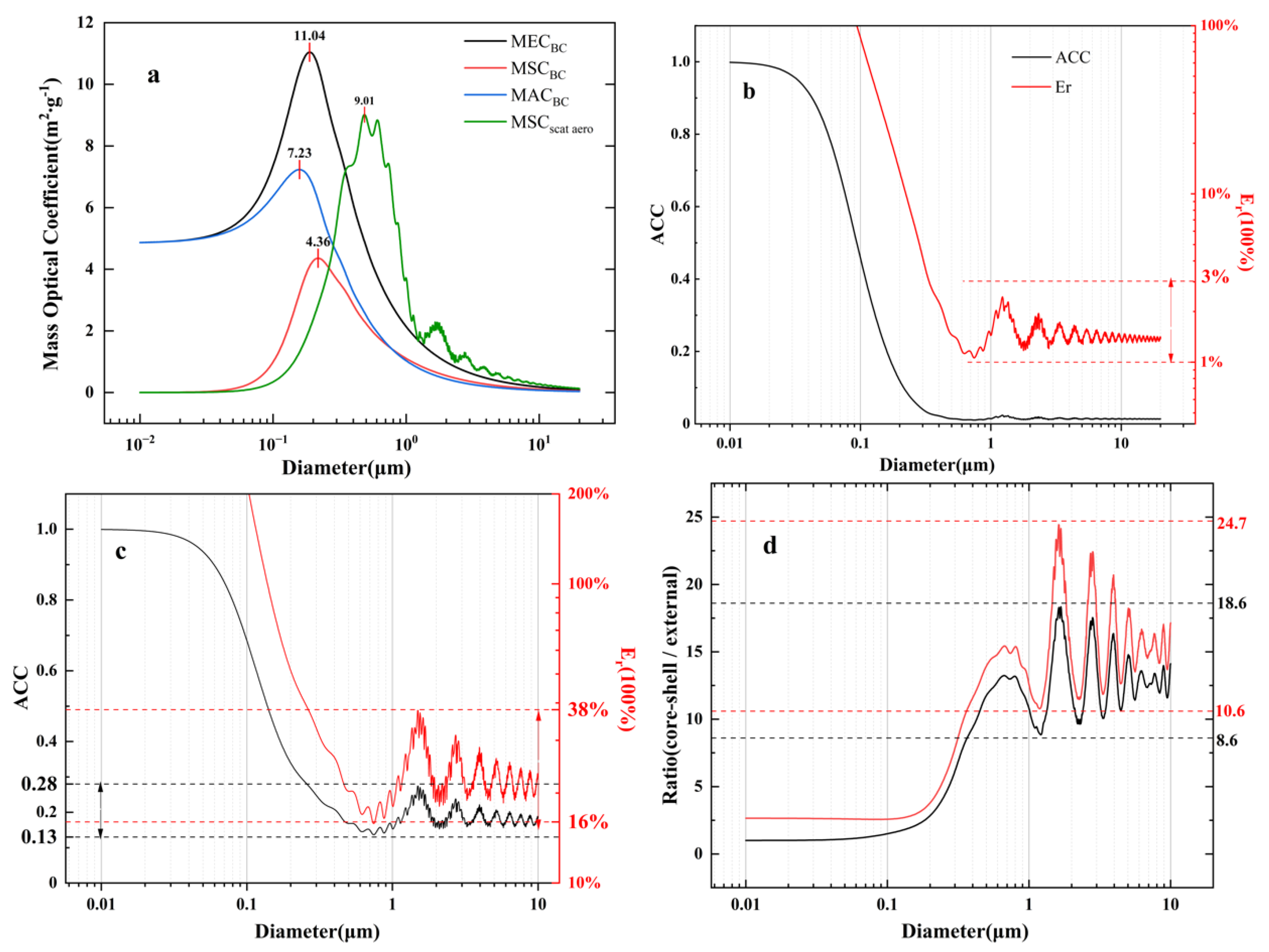
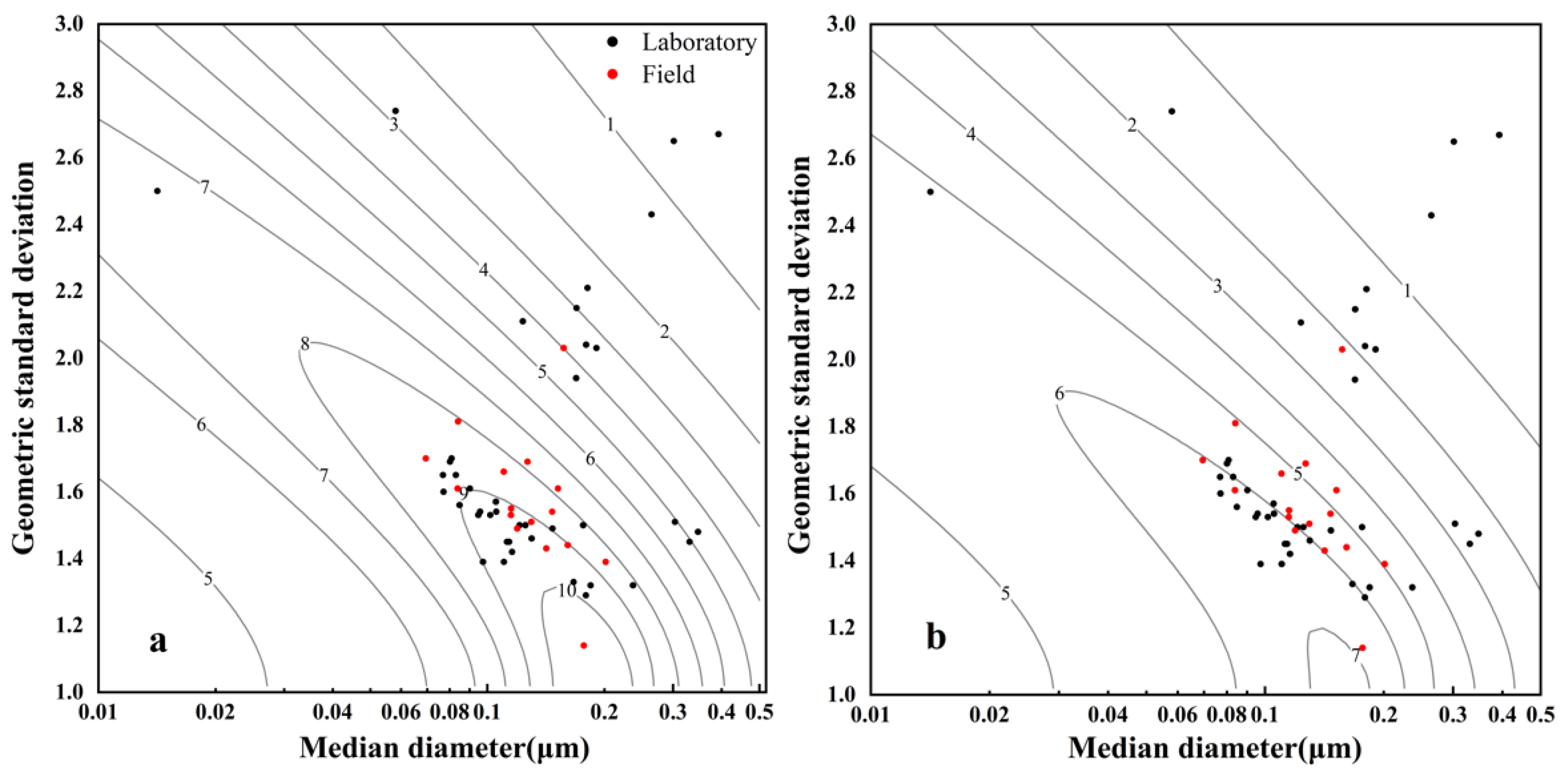
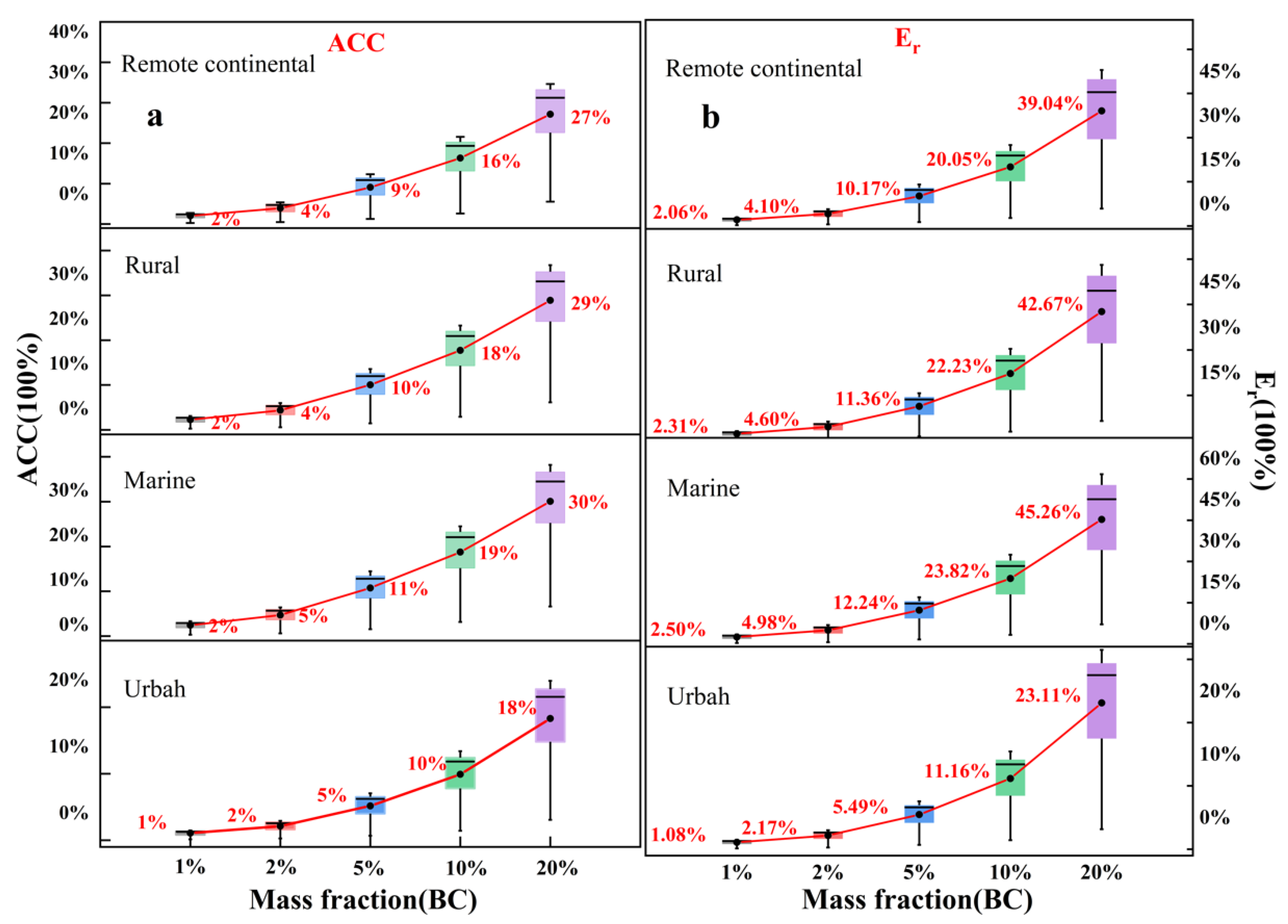
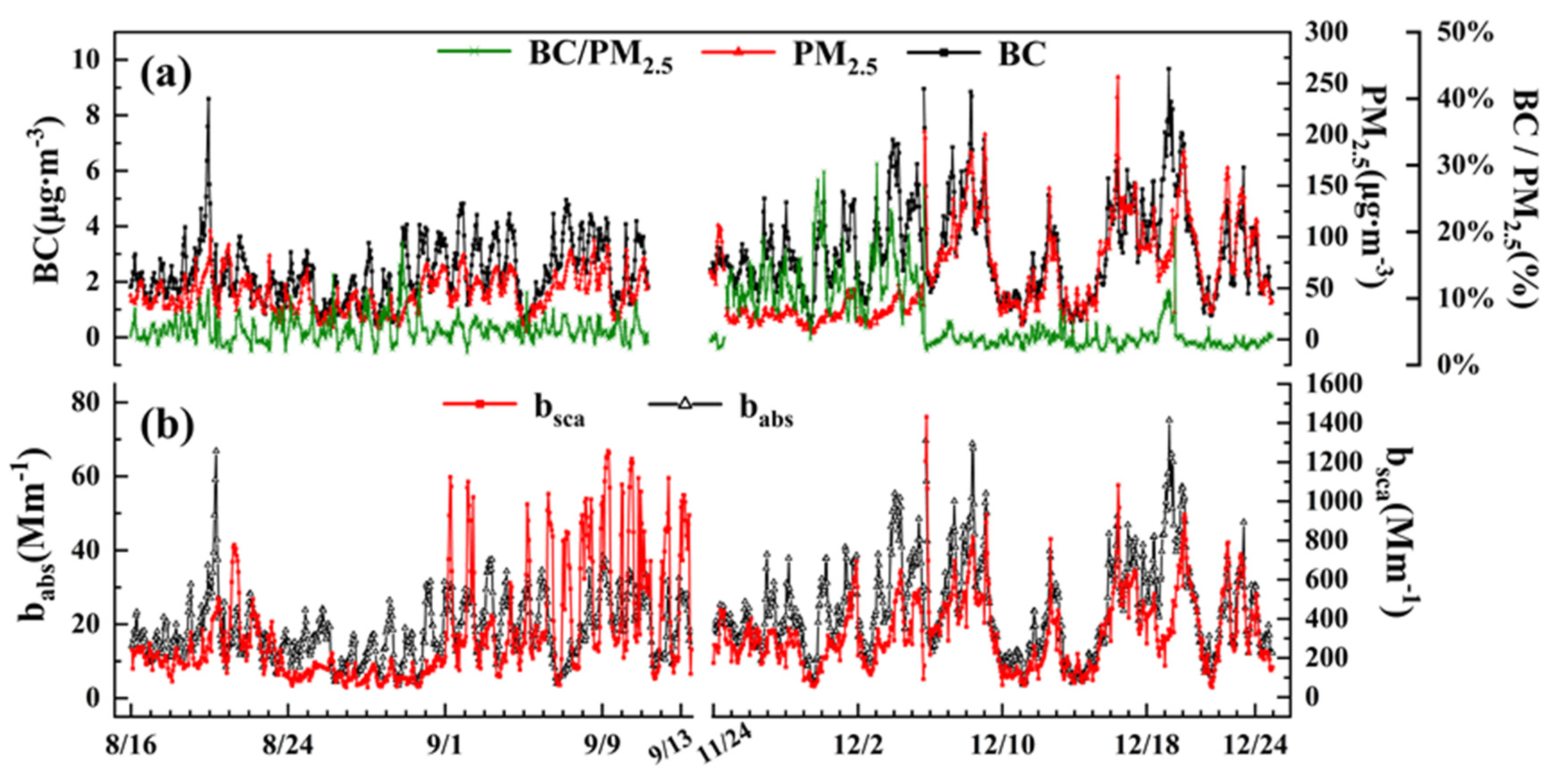
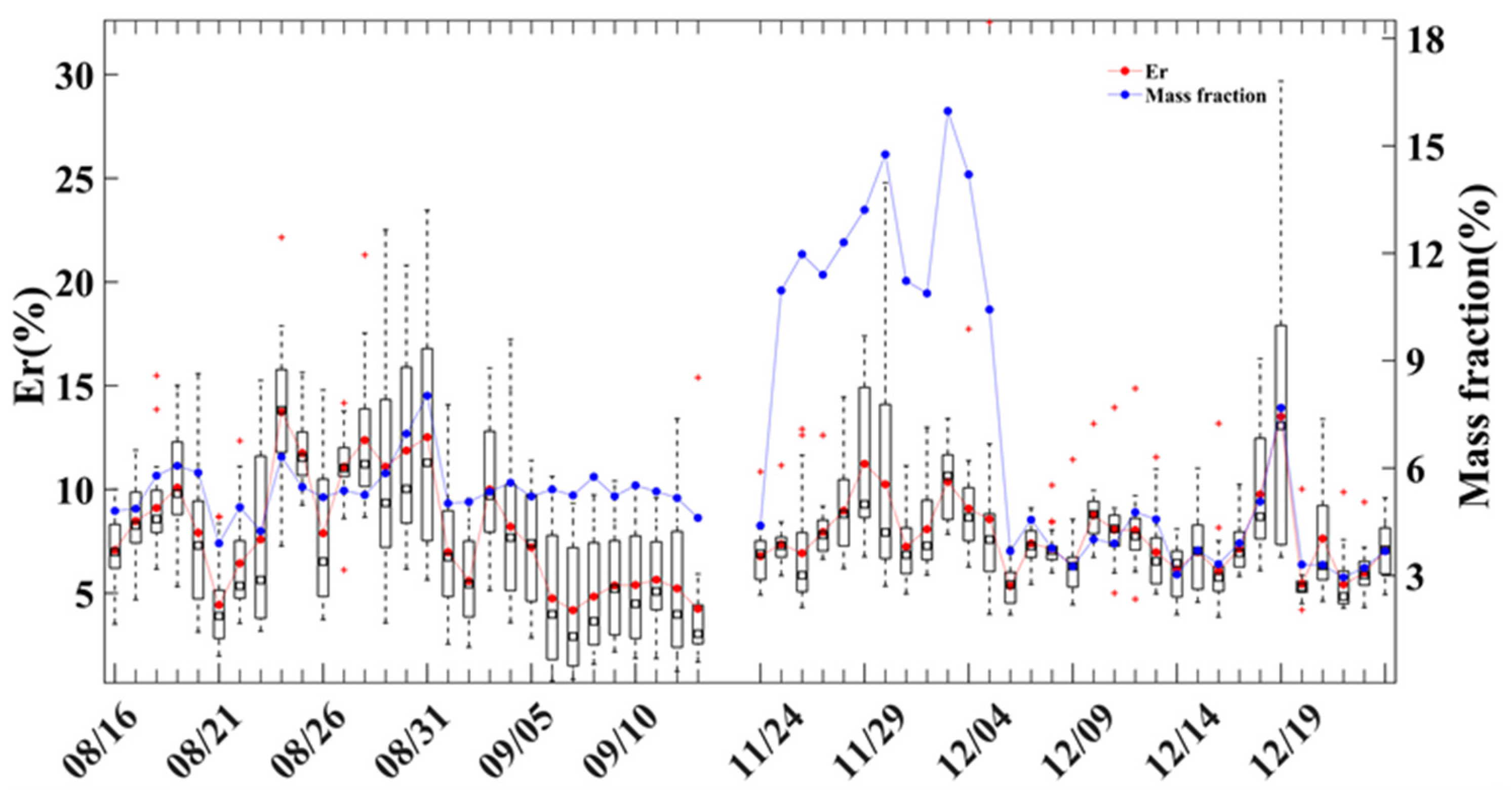
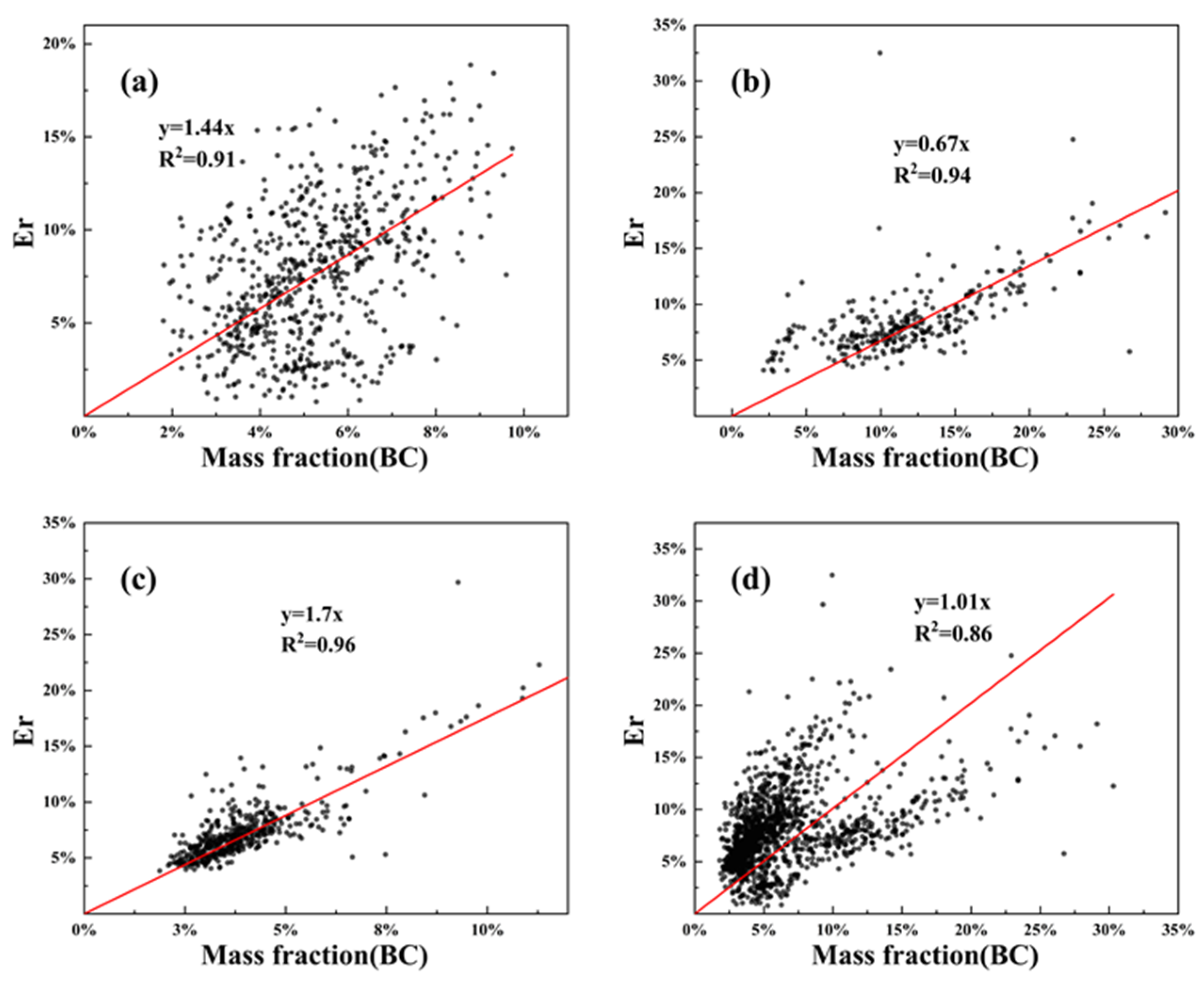

| Aerosol Category | Formula | Efficiency Factor Program | Output Results |
|---|---|---|---|
| Monodisperse Aerosols | Mie Scattering | External Model Particles State | |
| MatScat | Core–Shell Model Particles | ||
| Log-Normal Distributions | MatScat | External mixing state Particles with Different Size Distributions | |
Disclaimer/Publisher’s Note: The statements, opinions and data contained in all publications are solely those of the individual author(s) and contributor(s) and not of MDPI and/or the editor(s). MDPI and/or the editor(s) disclaim responsibility for any injury to people or property resulting from any ideas, methods, instructions or products referred to in the content. |
© 2025 by the authors. Licensee MDPI, Basel, Switzerland. This article is an open access article distributed under the terms and conditions of the Creative Commons Attribution (CC BY) license (https://creativecommons.org/licenses/by/4.0/).
Share and Cite
Yang, Z.; Zhang, Z.; Guo, H.; Wang, J. Influence of Black Carbon on Measurement Errors in Scattering-Based Visibility Meters. Atmosphere 2025, 16, 467. https://doi.org/10.3390/atmos16040467
Yang Z, Zhang Z, Guo H, Wang J. Influence of Black Carbon on Measurement Errors in Scattering-Based Visibility Meters. Atmosphere. 2025; 16(4):467. https://doi.org/10.3390/atmos16040467
Chicago/Turabian StyleYang, Zhihua, Zefeng Zhang, Hengnan Guo, and Jing Wang. 2025. "Influence of Black Carbon on Measurement Errors in Scattering-Based Visibility Meters" Atmosphere 16, no. 4: 467. https://doi.org/10.3390/atmos16040467
APA StyleYang, Z., Zhang, Z., Guo, H., & Wang, J. (2025). Influence of Black Carbon on Measurement Errors in Scattering-Based Visibility Meters. Atmosphere, 16(4), 467. https://doi.org/10.3390/atmos16040467






